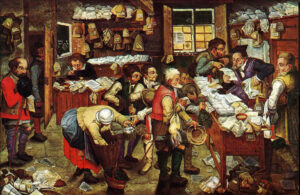
In the first part of this series, Simon Bytheway discussed the origins and early functions of various monies. After explaining what money and monetary theories are, he then examined archaeological discoveries and the earliest historical records to find out what they tell us about the competing commodity and claim theories. Today, he will take a close look at the works of Alfred Mitchell-Innes – a pioneer in the development of the Credit Theory of Money – to find out what his writing tells us about monetary theories, and the wider socio-economic meaning of money.
A key, if long-overlooked, pioneer in monetary theory is Alfred Mitchell-Innes, the author of just two articles, both of which became seminal works: “What is Money?” and “The Credit Theory of Money” published in the Banking Law Journal of May 1913 and January 1914. Mitchell-Innes critiqued the dominant, contemporary “metallist theory of money” by pointing out that the earliest known coins were irregular in weight and fineness, and could not be related to any metallic standard. More importantly, early coins did not possess any numerical indication of their value. He had no doubts about what he was looking at: coins were credit instruments that represented abstract value or purchasing power.

Money Is Not Natural or Universal
The Ricardian notion that “there can be no unerring measure of value unless there be some object in nature to which the standard itself can be referred” was similarly disproven and quickly dispensed with by Mitchell-Innes. The theory of an abstract standard for money was the same as all other measures for Mitchell-Innes: “No one has ever seen an ounce or a foot or an hour” (Mitchell-Innes 2005 [1914]: 358-9). Just as weight (the force of gravity) is far from constant, varies subtly in each context, and in not exerted equally everywhere, so too, credit and debts are abstract notions, developed in certain socio-economic contexts.
Indeed, the measure and value of money fluctuates in response to the distribution and redistribution of social and economic power. There is no such thing as a natural monetary standard or “natural money”, in fact, money is not necessarily a thing at all. Indeed, Mark Metzler makes it clear in his Capital as Will and Imagination that money and credit are not so much things, but rather powerful expressions of social relations or potential relations.
I can give you some concrete examples from my own research. For example, the huge 78- and 44- year loans raised in London for the Japanese cities of Osaka and Yokohama during the 1900s were much more than simple commercial transactions, they were providing for the long-term development of socio-economic and political relations between two empires: Great Britain and Japan. On a personal level too, inter-generational housing loans and serial short-term, pre-harvest lending to families in agricultural communities are not just monetary “things”, they are sincere financial expressions of important social relationships.

Money as Tax
One can only speculate on what drove Mitchell-Inness to write so passionately about money, but perhaps a key quote is:
“Whenever a tax is imposed, each taxpayer becomes responsible for the redemption of a small part of the debt which the government has contracted by its issues of money, whether coins, certificates, notes, drafts on the treasury, or by whatever name this money is called. …The redemption of government debt by taxation is the basic law of coinage and of any issue of government ‘money’ in whatever form.” – Alfred Mitchell-Innes, The Credit Theory of Money, The Banking Law Journal.
Mitchell-Inness seems to have been intensely sensitive to the creation of government credit by the application of broad-based, public taxation: “that the more government money there is in circulation, the poorer we are” and suggests that “of all the principles which we may learn from the credit theory, none is more important than this” (Mitchell-Innes 2005 [1914]: 355). And yet his “credit theory” is continually revisited and praised. Indeed, “The Credit Theory of Money” ends with him providing a strikingly polemic summary of the credit theory in the form of statements, or more properly slogans, of which I will only quote a fraction.
“There is no such thing as a mechanism of exchange.
A sale and purchase is the exchange of a commodity for a credit.
The object of commerce is the acquisition of credits.
A coin is an instrument of credit or token of indebtedness; identical in its nature… with any other form of money, by whoever issued.
The issue of money is not an exclusive privilege of government, but merely one of its functions… Money in one form or another is, in fact, issued by banks, merchants, etc.
Until modern days, there never was any fixed relationship between the monetary unit and the coinage.
Precious metals are not a standard of value.
The government stamp on a piece of gold changes the character of the gold from that of a mere commodity to that of a token of indebtedness. The nominal value of the dollar coin exceeds the market value of the gold of which it is made. Coins can only remain in circulation for any length of time if their nominal value exceeds their intrinsic value.” (All quotes taken from Mitchell-Innes 2005 [1914]: 372-3)
In conclusion, the ageless mantra of gold miners everywhere, “gold is money, and everything else is credit” had been turned on its head: “Credit and credit alone is money”. And of that Mitchell-Innes had no doubts. Note the economy of his language and its complete lack of equivocation, qualifications, or conditional clauses. Mitchell-Innes exhibits a seemingly all-knowing, Byzantium “Christ-of-all-ages” insight into the nature of what money is! No wonder he collected famous admirers and disciples.

Towards a New Understanding: Mitchell-Innes and Keynes
Critical to our discussion here, Keynes reviewed Mitchell-Innes’s work in the most favourable of terms, and years later something of its concise, cutting, revelatory, and indeed, revolutionary nature seems to have informed his own highly influential works. Most especially in Keynes’s infinitely more widely read A Tract on Monetary Reform (1923), in which Keynes launched his most shocking attack against the gold standard:
“In truth, the gold standard is already a barbarous relic…Advocates of the ancient standard do not observe how remote it now is from the spirit and requirements of the age. A regulated non-metallic standard has slipped in unnoticed. It exists”. (J. M. Keynes 1923: 172)
Here Keynes, like Mitchell-Innes before him, creates his own “special atmosphere… of revealing esoteric knowledge, of profaning sacred wisdom” as might a prophet or visionary. That said, even if we believe that Keynes was able to see the future of money and monetary standards in his own time, how can the ideas of men like Mitchell-Innes and Keynes help us understand money in our present (twenty-first century) age of digital cryptocurrencies, and electronic monies?
Let’s continue the conversation!
Please look out for the final article in this Numismatist’s Guide to Money series, The Future of Money, where Simon Bytheway examines the “moneyness” of new digital monies, cryptocurrencies, and varied media of exchange to find out what they tell us about competing national and regional currencies, and the wider socio-economic meaning of money in our ever-changing world.
Author’s note: The thoughts presented here are based on my earlier “Conceptualizing Money: from Commodity Monies to Cryptocurrencies” (2017) article, with thanks to the editors and publishers. I hope to present a full bibliography of sources and additional readings at the conclusion of the Numismatist’s Guide to Money series.
If you missed the previous parts of this series, here you can read part 1: What Does Money Do? Here is part 2: Theories of Money. And this is part 3: the Origins of Money
For more information on the author, read Simon Bytheway’s Who’s who entry.




